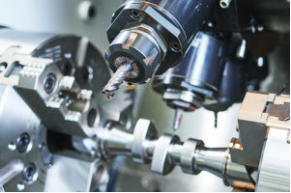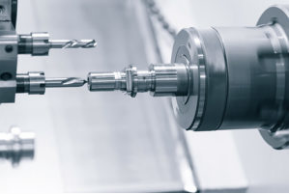Hotest Articles

CNC machining is a versatile manufacturing process that is compatible with a wide range of materials. However, in product manufacturing, the process is more common with the use of aluminum, i.e., aluminum machining. Aluminum machining is a process that involves the use of aluminum in product manufacturing due to its availability in numerous grades. Aluminum is highly machinable and relatively affordable, and the different types of aluminum alloys are applicable in a myriad of machining applications. This includes rigid architectural components, aerospace parts manufacturing, etc.

Indeed, when used in machining, the different types of aluminum alloys possess some distinct and unique advantages. They come in a range of options which gives you huge flexibility when embarking on a machining project. However, narrowing the best aluminum alloy for the job also becomes harder.
This guide attempts to provide a quick comparison of five of the most common aluminum alloys for machining. It does this by introducing aluminum alloys, highlighting their compositions, common applications, and the industries they regularly use.
What Are Alloys?
An alloy is a metal mixed with either other metals or non-metallic elements. Aluminum alloys are materials used in machining, and they largely consist of aluminum and other elements such as iron, copper, and magnesium.

Machining aluminum alloys hugely depends on their composition. Therefore, different aluminum alloys are suitable for different applications. It is noteworthy that the mixture of other elements affects an alloy’s physical properties, such as strength, ductility, and corrosion resistance. Therefore, knowing these properties can help a company decide whether the material is suitable for a given part.
Aluminum alloys used have three groups: commercially pure aluminum, heat-treatable alloys, and non-heat-treatable alloys. Commercially pure aluminum is less regularly used in aluminum machining (however, machine parts use aluminum 1060). Therefore, this article focuses on five alloys from the latter two groups.
Most Common Aluminum Alloys for Aluminum Machining
There are many ways to categorize the different types of aluminum used in CNC machining. A common practice is the use of aluminum grade, such as 1xxxx, 2xxx, to 7xxx. The difference lies in the composition, which as a result, infects the properties of different aluminum alloys. In this article, however, we are not going to talk about all series of aluminum alloys. We are introducing the most common aluminum alloys for machining by their heat treatment feature.
Heat-Treatable Alloys
· Aluminum 2024

Aluminum 2024 is one of the most common aluminum alloys for machining from the 2xxx group.
It is a widely used ‘duralumin’ aluminum and copper alloyed material with an excellent strength-to-weight ratio. It is also resistant to fatigue but fairly susceptible to corrosion.
Tensile strength: 68,000 psi.
Major alloying elements: Copper
Industries: Automotive, aerospace, transportation.
Products: Car parts, aircraft parts, transport vehicle parts, structural parts, electronics.
· Aluminum 6061

Aluminum 6061 is one of the most common aluminum alloys for machining in the 6xxx series. It is also one of the most versatile of all machinable alloys making it a top choice in CNC machining. Aluminum machining uses aluminum 6061 to make a wide range of products. This includes electronic and aircraft parts.
Tensile strength: 45,000 psi.
Major alloying elements: Magnesium, Silicon
Industries: General manufacturing, aerospace, consumer goods, architecture
Products: Structural parts, steps, platforms, covers, truck bodies, valves, pipes, aircraft parts, computer parts, electronics.
· Aluminum 7075

This is one of the most common aluminum alloys for machining used for highly stressed structural applications. Aluminum 7075 is an important material for making structural aircraft parts and sports equipment, tooling, and more. It is heat-treatable, ductile, strong, and tough. However, it can also become brittle.
Tensile strength: 83,000 psi.
Major alloying elements: Zinc
Industries: Aerospace, transportation, sporting goods.
Products: Aircraft parts, transport vehicle parts, bicycles, golf clubs, weapons.
Non-Heat Treatable Alloys
· Aluminum 3003

Aluminum 3003 is one of the common types of aluminum alloy used in aluminum machining (across all manufacturing processes). It is a near-pure aluminum alloyed with Manganese. It is ideal for making household goods like cooking equipment.
Tensile strength: 13,000 psi.
Major alloying elements: Manganese
Industries: Household goods, chemicals
Products: Cooking utensils, kitchen equipment, tanks, siding and trim, roofing, chemical equipment.
· Aluminum 5052

Strong, workable, and corrosion-resistant, Aluminum 5052 — made with magnesium and chromium, amongst other components — is widely used in marine applications because of its resistance to saltwater. It is also the strongest non-heat-treatable alloy available.
Tensile strength: 33,000 psi
Major alloying elements: Magnesium, chromium
Industries: Marine, aerospace, architecture, electrical, oil and gas
Products: Marine transport parts, heat exchangers, aircraft parts, fuel lines, fuel tanks, panels, household appliances, commercial and heavy-duty cooking equipment
Using the Aluminum Alloy Chart in Aluminum Machining
Knowing the different types of aluminum alloys for machining isn’t enough. You need to take one step further and learn about the machinability of aluminum alloys, i.e., how to choose the right aluminum type for machining purposes. Below are the most important factors to consider:
Formability / Workability
Weldability
Machinability
Corrosion resistance
Heat treatment
Strength
End-use applications
Aluminum Alloy Chart
To save you some time, we have sorted out an aluminum alloy chart for a quick reference of your ideal aluminum alloy:

Why GUAN SHENG Is Your Guarantee of Aluminum Machining Freedom
After going through this article, undoubtedly, you will know a little about the different types of aluminum alloys used in CNC machining. This is a great leap forward. However, if you’re unsure about the kind of aluminum alloy that suits your parts or prototypes — or if you need to machine your part from an alloy that is not on the list — you can request an instant quote and get in touch with us.
GUAN SHENG gives the option of some 20 aluminum alloys for its CNC machining services. We also offer a wide choice of nearly 100 materials for other manufacturing processes such as CNC machining, sheet metal fabrication, injection molding services.
To get an instant quote from us with the aluminum alloys listed in our supported material list, select the alloy from the drop-down list of materials. You can also choose one of many non-aluminum materials instead. With this information, we can help you decide on the best material for the job. Therefore, we will ensure that your parts are exactly as you want them.
Conclusion
Aluminum machining is a popular product manufacturing process due to the features and properties of aluminum. The use of the alloys of aluminum further improves the material’s features and properties. Therefore, making them better for the process (although they can also be negative). This article showed the most common aluminum alloys for machining. It introduced the types of aluminum alloys and highlighted their composition using an aluminum alloy chart. Definitely, by going through the article, you will pick up a thing or two about the different types of aluminum alloys used in product manufacturing.






